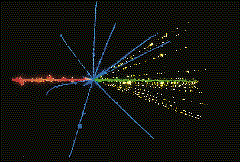| In addition to stars, gas, dust, and dark matter, one other type of matter populates our Galaxy, namely, cosmic-ray particles, or cosmic rays for short. Cosmic rays continuously collide with Earth, and they make up our only samples of matter from outside the solar system.
In recent decades high-altitude balloons, rockets, and satellites have enabled astronomers to discover the chemical composition and the energies of cosmic-ray particles. Cosmic rays are actually not "rays" at all. They are subatomic particles. Nearly 90 percent are protons, the nuclei of hydrogen atoms. The nuclei of heavier atoms—helium and a long list of others—make up 9 percent. Electrons amount to 1 percent. The abundances of elements that make up the cosmic rays are close to those we see throughout the Galaxy.
Cosmic-ray particles are very energetic. By some unknown mechanism(s), cosmic rays are accelerated to extremely high velocities, much higher than any velocities we can achieve in terrestrial laboratories. Virtually all cosmic rays—even the heaviest—travel very close to the speed of light. When a galactic cosmic-ray particle hits our atmosphere, it creates a series of cascades or "showers" of many lower-energy particles. These lower-energy "secondary" particles in turn collide with objects, including humans, on Earth's surface virtually all the time. Your body is being peppered with them right now.
The accompanying photograph shows an actual track of a cosmic-ray particle—in this case, the nucleus of a sulfur atom (shown in red in this false-color image). Entering from the left, the particle collides with the nucleus of an atom in the photographic emulsion, producing a fluorine nucleus (green), other nuclear fragments (blue), and a multitude of subatomic particles (yellow).
On the basis of the numbers of cosmic rays hitting Earth, astronomers estimate the number density of cosmic rays in interstellar space to |
be on the order of 10-3 particle/m3. That makes them rare, although still more numerous than interstellar dust particles.
What is the source of our Galaxy's cosmic rays? The answer is currently uncertain. The circuitous and complex paths taken by the cosmic-ray particles while traversing the Galaxy, with its tangled magnetic field, prevent us from pinpointing their source by observing their direction of arrival at Earth. Indeed, careful searches have failed to show any preferential direction for cosmic rays. They seem to arrive from all directions with equal likelihood. Candidates for the origin of cosmic rays include (1) violent events at the Galactic center, where strong electromagnetic forces accelerate these particles to high energies; (2) supernova explosions, described in Chapter 21; and (3) the vicinity of neutron stars and black holes, as discussed in Chapter 22.
Most researchers currently favor the second of these explanations, although each of these candidate events probably contributes some particles to the observed hodgepodge of cosmic rays in our Galaxy. Some of the highest-energy cosmic rays may even originate at great distances, in the hearts of galaxies far beyond our own.

|